Hazelnut And Chocolate Layer Cake (Hungarian Esterhazy Torte)
This Hungarian and Chocolate Layer Cake is soft and melt in your mouth with layers of nutty, rich hazelnut dacquoise and deeply chocolatey pastry cream. It’s coated in toasted hazelnuts and finished with a smooth chocolate and vanilla glaze. It’s an ultra-indulgent cake that leans more project than quick dessert, but the payoff is worth the effort!
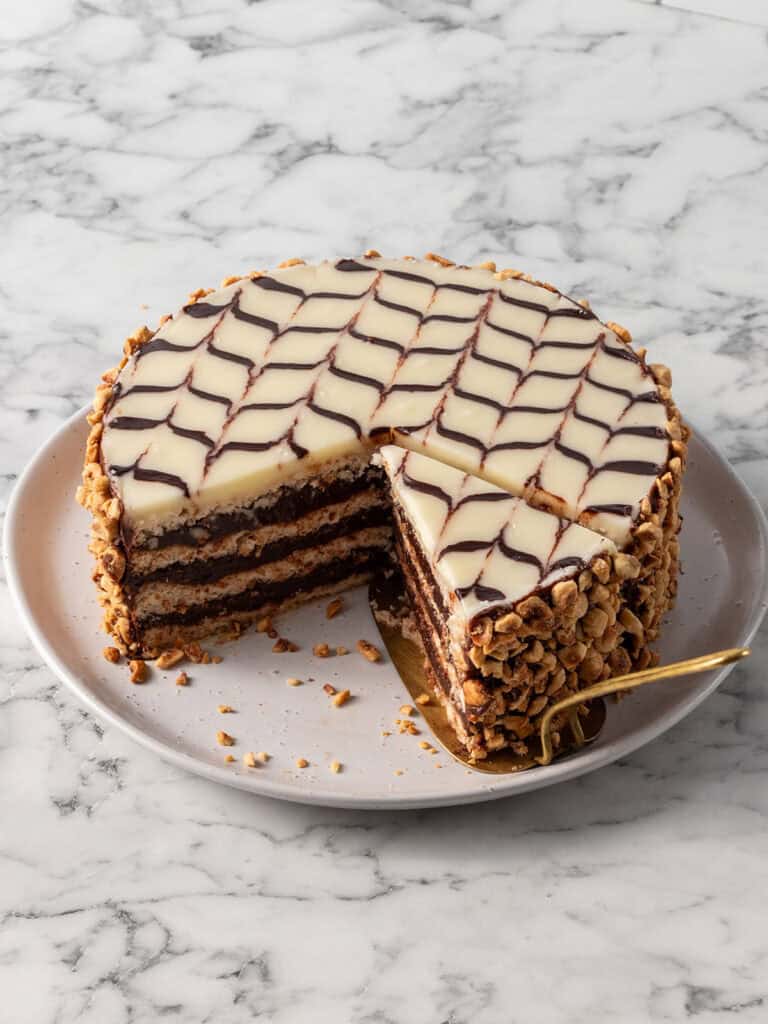
Hey team, Nick here! If there’s one thing I go weak at the knees at, it’s a classic looking European cake like this. You just know you’re in for a treat when there’s a feathered glaze on top of a dessert. This is my take on an Esterhazy Torte which is a classic Hungarian cake typically made using walnuts. I decided to add my own twist and use hazelnuts.
Just like my Chocolate Hazelnut Ferrero Rocher Cake, this cake is a project.There are a couple different elements that make up this chocolate hazelnut dessert. Silky chocolate pastry cream, toasted hazelnuts, a hazelnut sponge, a glaze and a hazelnut praline paste. The good news is, you can make most of those things in advance which helps make things manageable. I broke it down in the
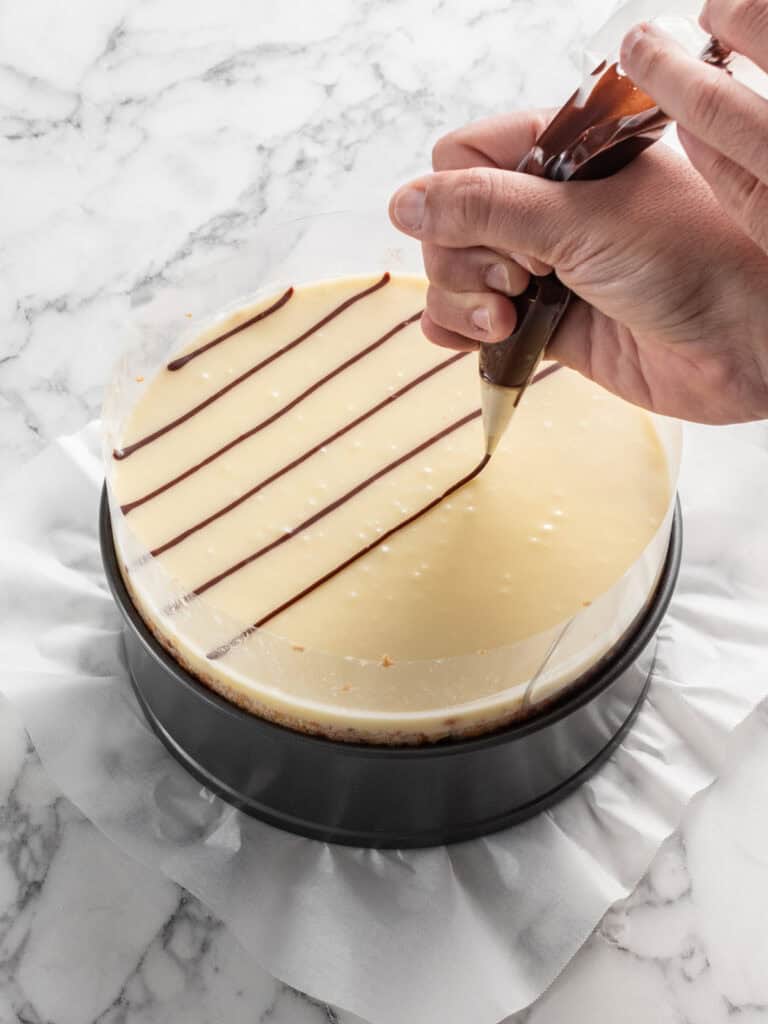
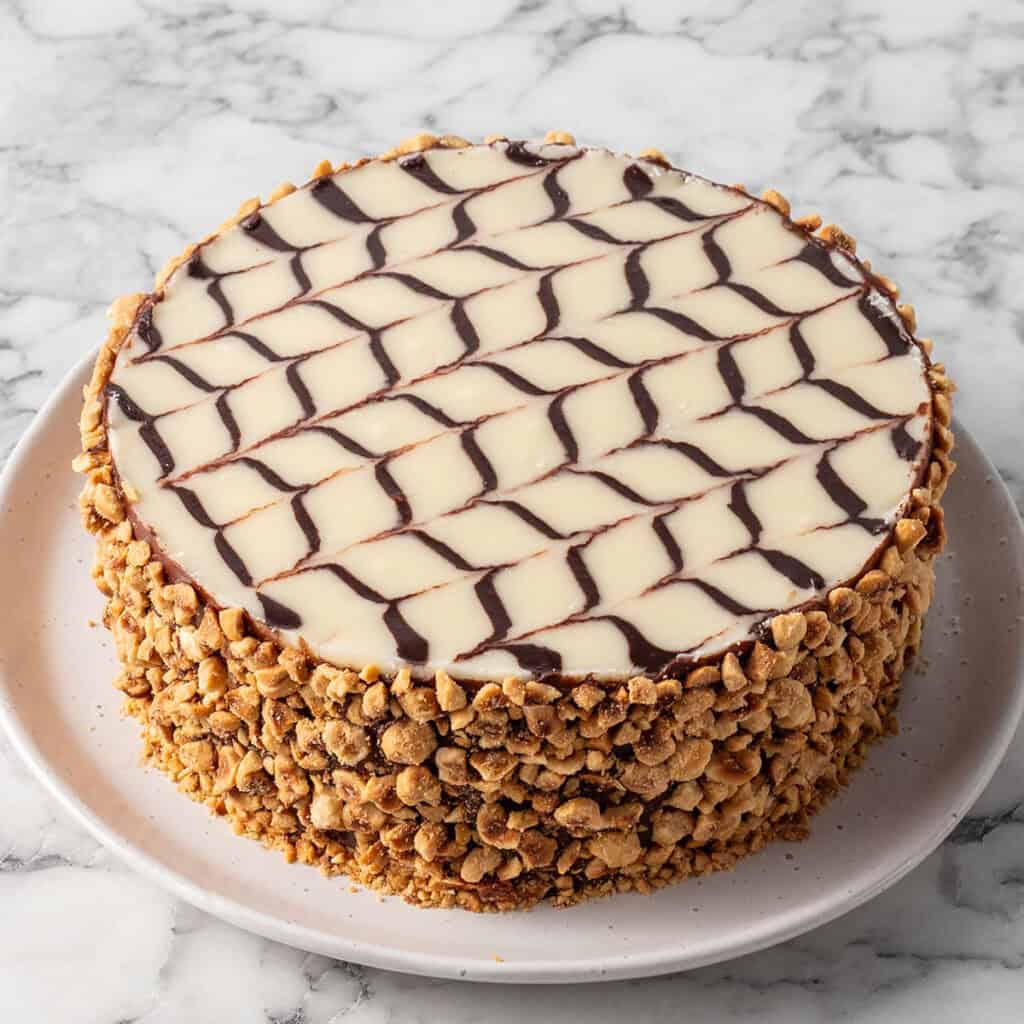
One thing that sticks out to me with this cake is how after the cake has set in the fridge overnight, each element gets to know each other and you get this ultra soft, melt in your mouth layer cake that honestly, feels like it was made by seasoned pastry chefs. Instead, this one was made right in your kitchen.
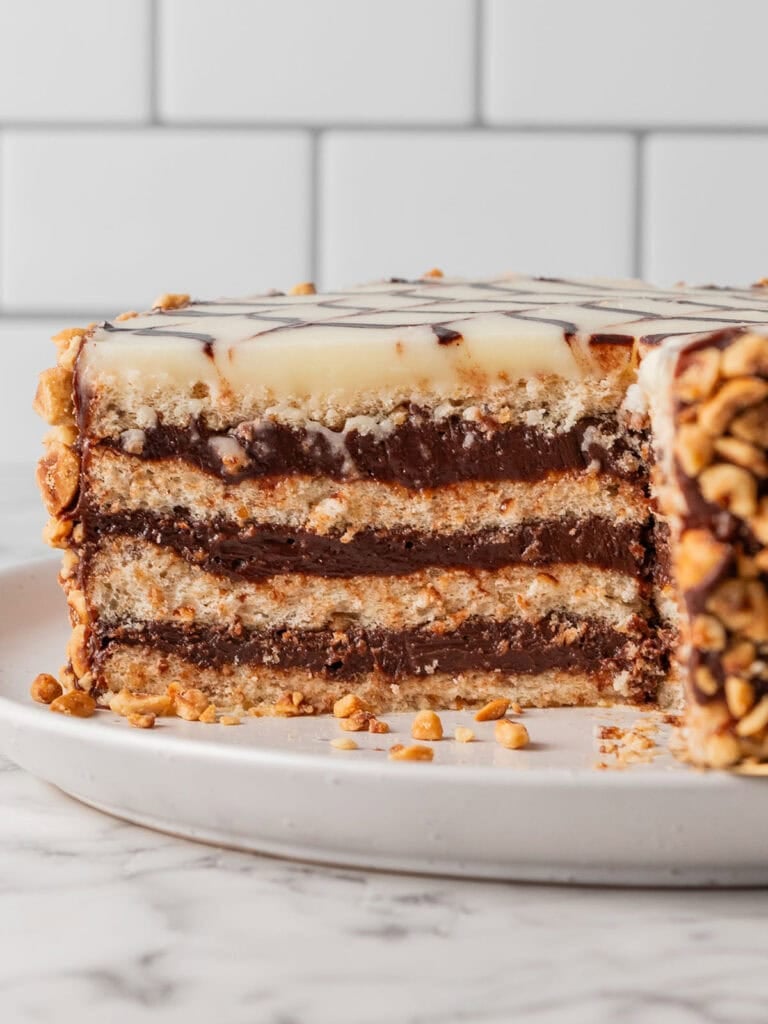
And because it’s such a special cake, it’s great for special occasions. I’ve made it for birthdays and fed a crowd with it. It’s rich in chocolate and hazelnut flavor, so a small slice goes a long way. I’m a fan of hazelnut desserts so I go in for two slices.
My workflow for making an Esterhazy Torte.
This cake might look a little over the top, but it’s totally manageable if you spread the steps out over a couple days. I’ve written out which day to make each element in the step by step section below so you won’t need to jump back and forth to figure it out.
Some parts need time to set or cool, so giving yourself the space to work through it makes the cake easier to make. It also means you’ll enjoy it more instead of rushing through or feeling overwelmed.
You’ll want to toast your hazelnuts (Day 1)
I love toasting the hazelnuts for this recipe. It brings out their natural oils which gives them a richer flavor and makes them crunchy. Goes so well with the soft silky cake textures.
You’ll need 450g total for this recipe. Some of it used for the praline, some for the dacquoise and then some to coat the cake when decorating.
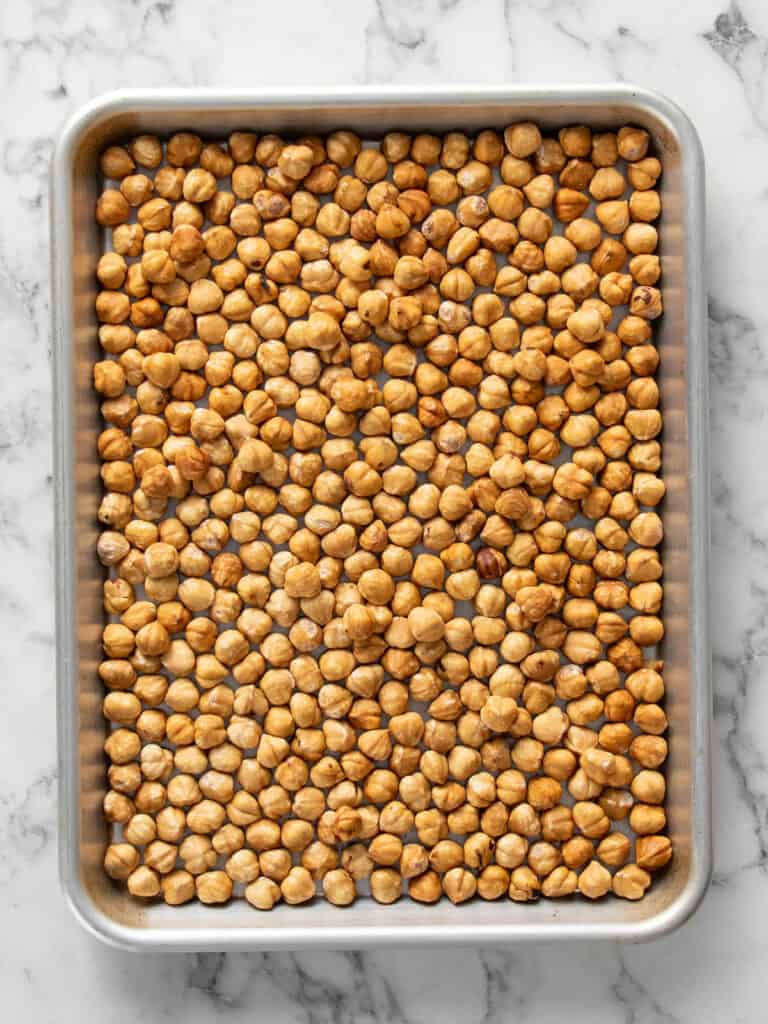
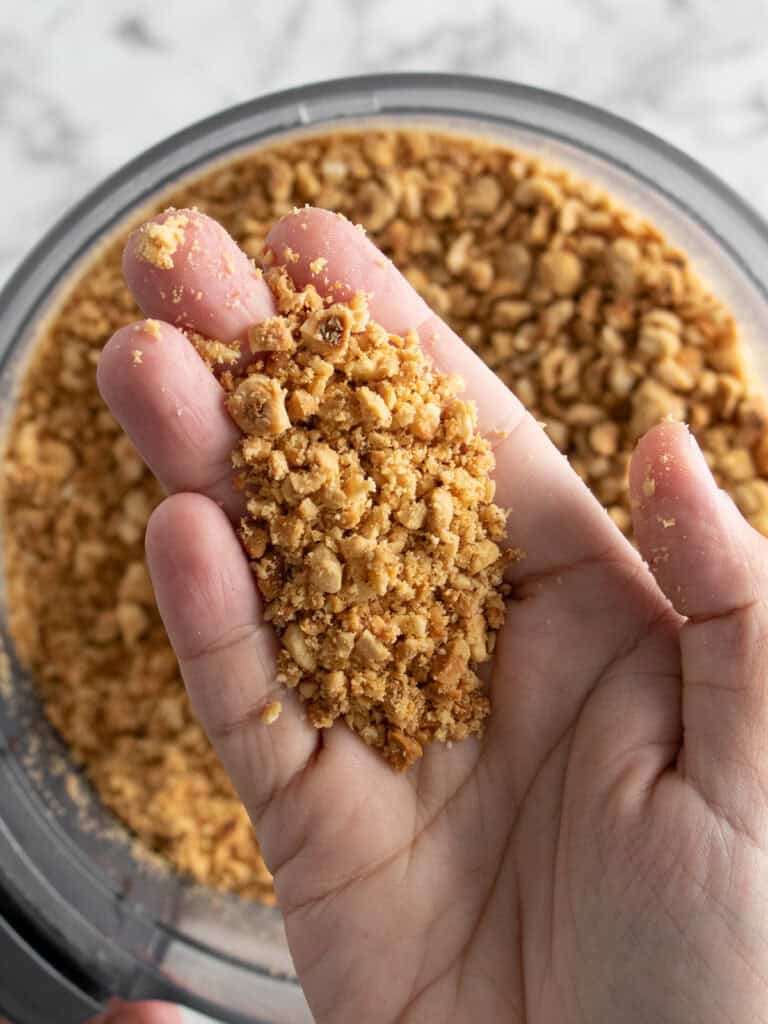
I spread them on a tray and bake at 180C / 355F (fan off), 160C / 325F (fan on) for 20 minutes, stirring halfway. Let them cool completely.
Tip: I make these days in advance sometimes and pop them into a zip lock bag until I’m ready to use them.
How to remove the skins from your hazelnuts
I buy mine already skinned but you can easily remove the skins from yours at home if they’re still on. Just roast them at 160C / 325F for 20 minutes. Then wrap them in a calean tea towel and rub them together until the skins come off. Don’t stress if a few stubborn bits stay on. They’re fine to use.
The chocolate pastry cream comes together in one pot! (Day 1)


I swear by my chocolate pastry cream. It’s deeply rich in chocolatey and silky. Plus, it holds its shape between cake layers which makes it perfect for this cake!

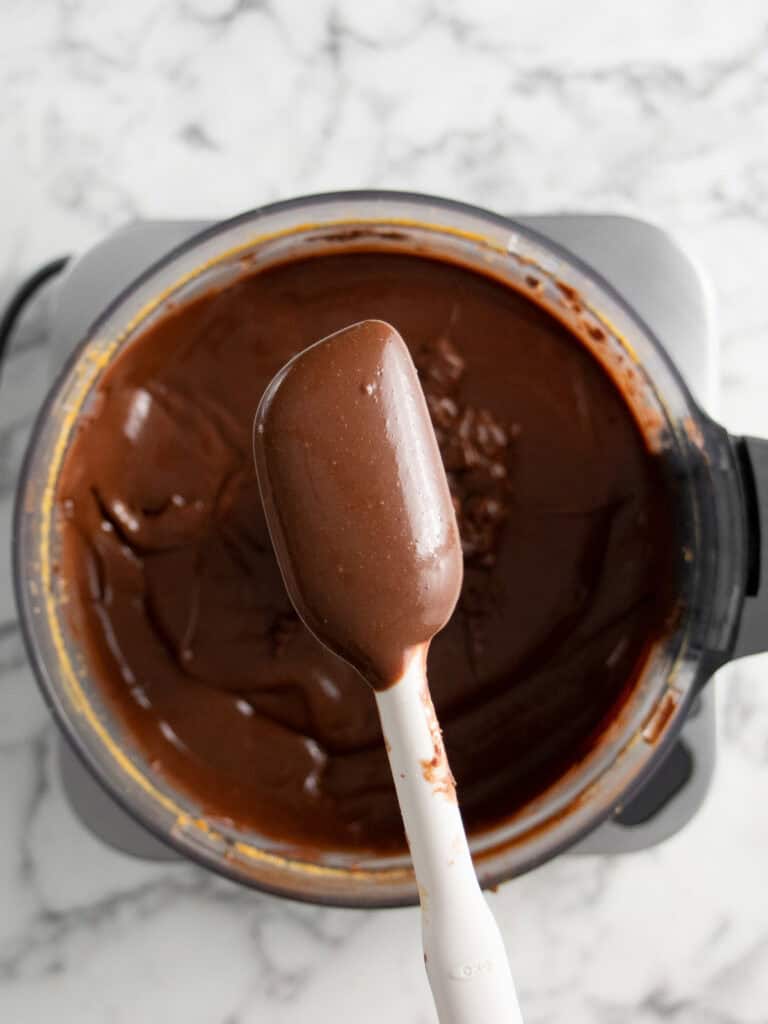
It comes together in one pot, and it uses simple ingredients like eggs, milk and butter. I like using both cocoa powder and cooking chocolate to take that chocolate flavor over the edge. Plus, the chocolate is what helps is set nice and thick.
Tip: I’d recommend making it the day before you put the cake together, so it has plenty of time to chill and set properly.
Making the hazelnut praline (Day 1 or 2)
One of the best things about this cake is the hazelnut praline. It adds an intense nutty and subtle caramel flavor which makes it irresistible. It’s absolutely incredible!
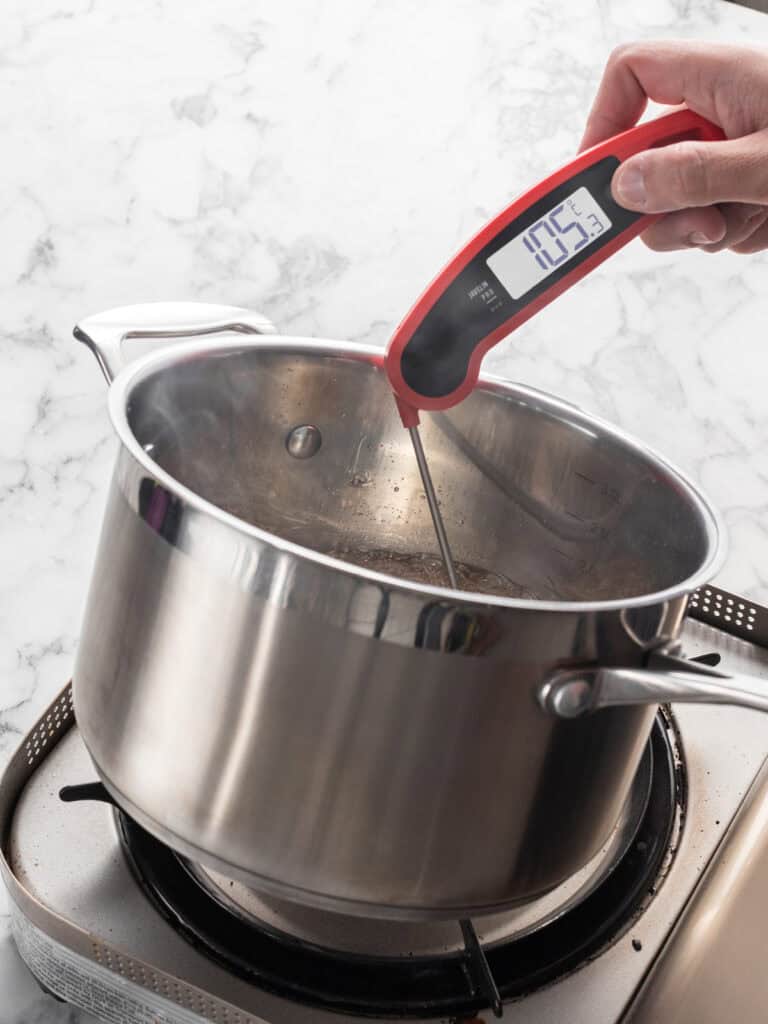
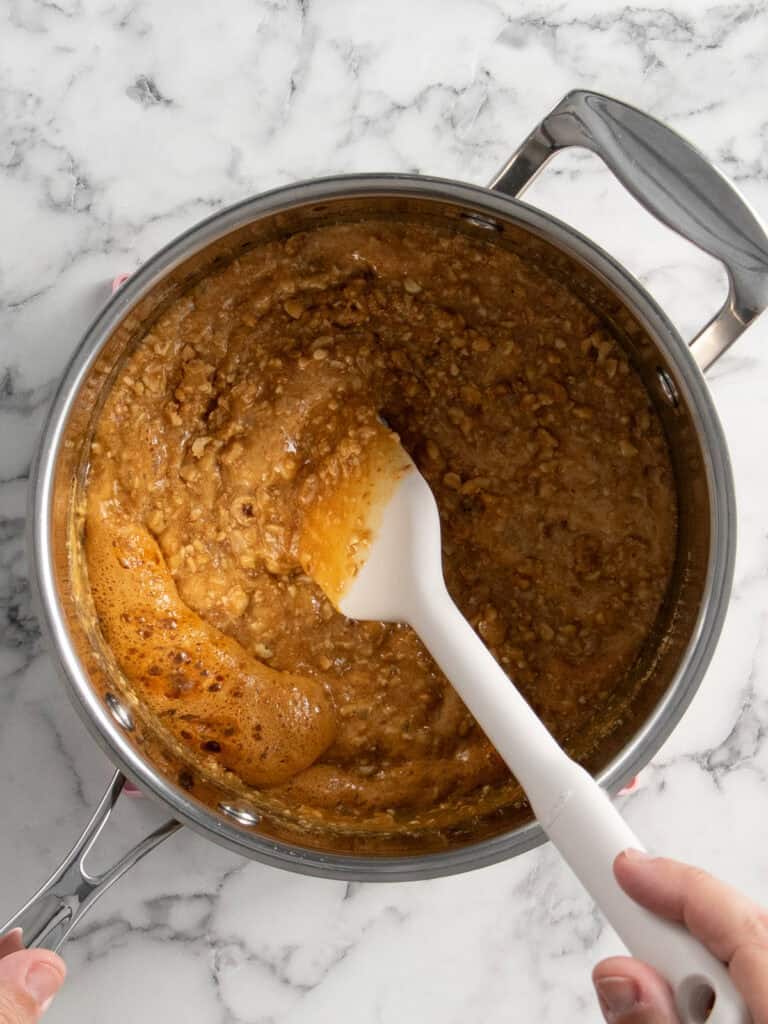
It starts by cooking the sugar, water and glucose syrup until golden and bubbling. Once it hits 160C, I stir in the salt and 150g of the toasted hazelnuts. Then add the bicarb soda and quickly stir.Pour it out to a baking tray that’s lightly oiled and let it cool and harden at room temperature
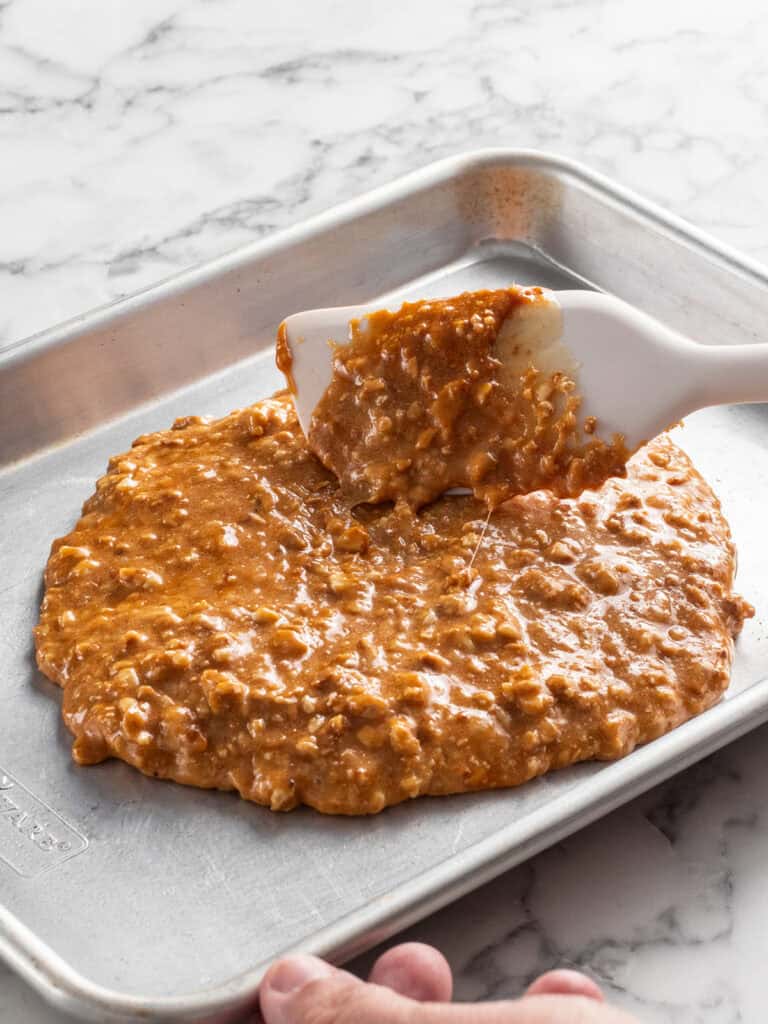
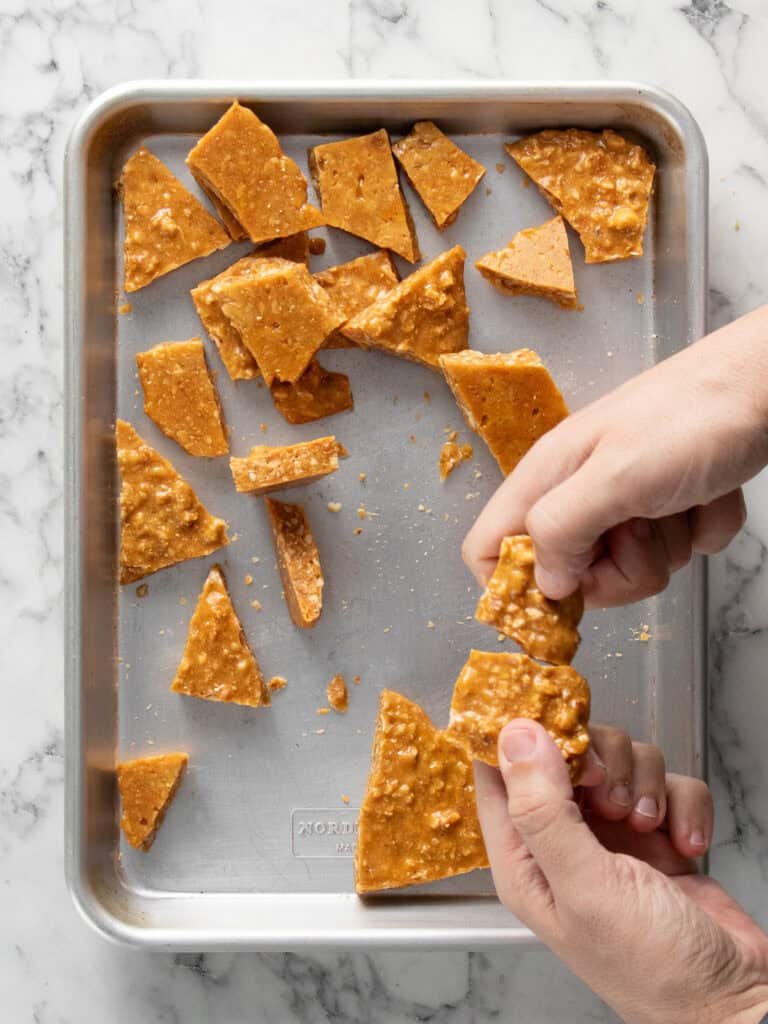
Once set, I break it into small pieces and blend it in a food processor. It’s loud and it can cause the machine to wobble around, so hold the processor down until it turns to powder. The goal here it to go slow and keep scraping the bowl down to make sure everything mixes evenly. Keep blending and scraping down the sides until it becomes a smooth paste.
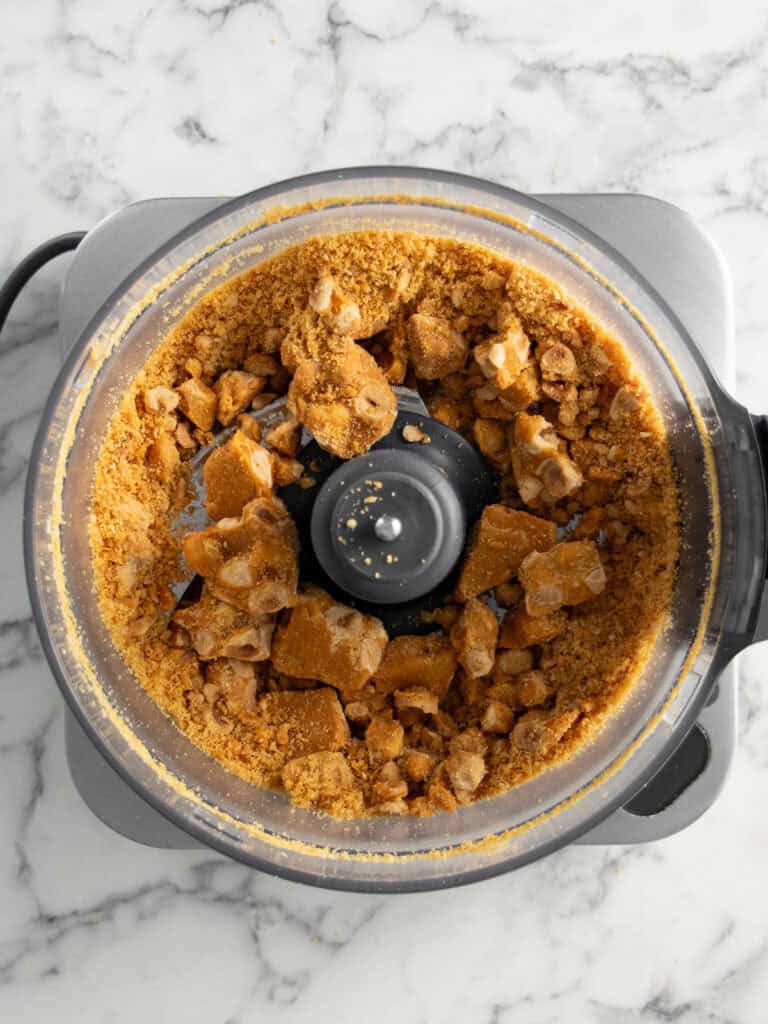
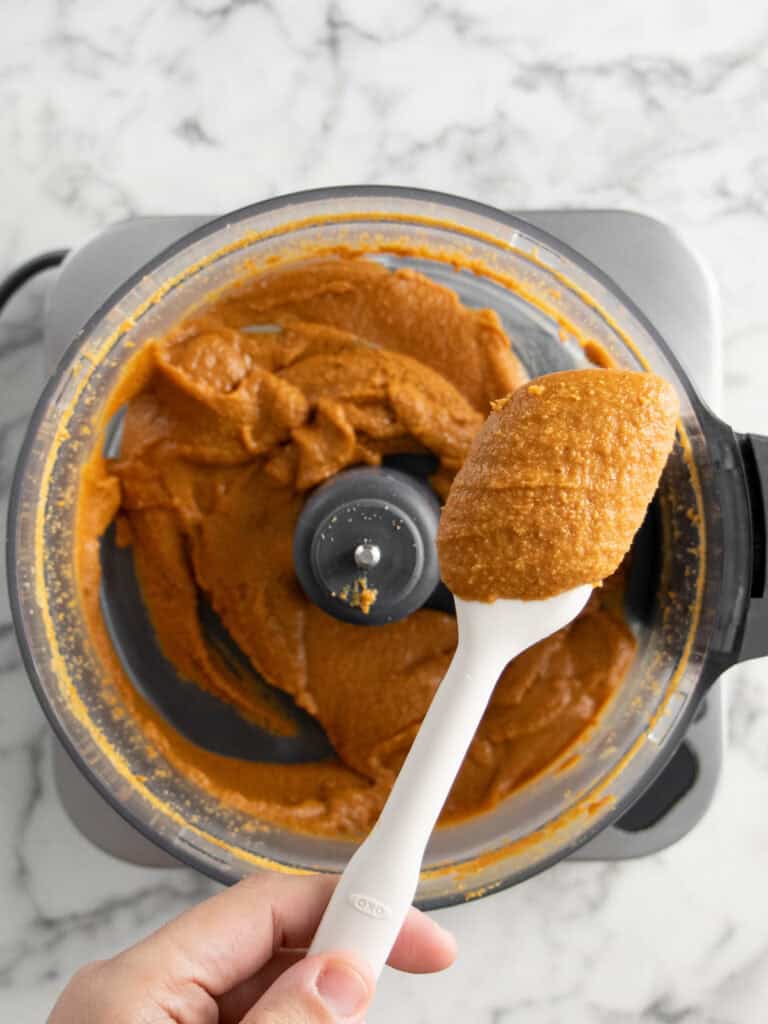
To finish, blend the chilled chocolate pastry cream with all the praline. It takes a minute to come together, but what you get is a rich, silky cream packed with hazelnut flavor. Once it’s done, pop it in the fridge until you’re ready to layer the cake.
TIP: You can make the praline days in advance and just store it in a jar or container and use it when you’re ready. It’s great in other things too. I haven’t tried it in frosting but if you do, let me know what you thought of it!
Hazelnut dacquoise sponge cake (Day 2)
I think the hazelnut dacquoise is where all that toasted hazelnut flavor really shines. It’s a soft sponge made mostly of meringue and toasted hazelnuts with a little bit of flour to hold everything together.
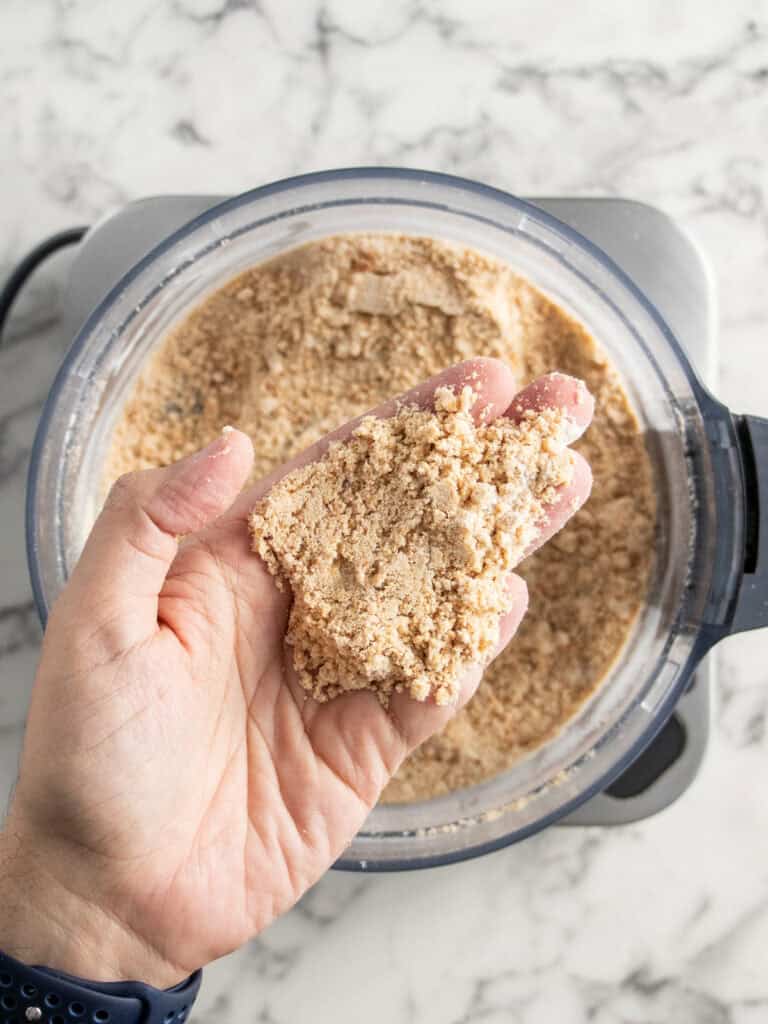
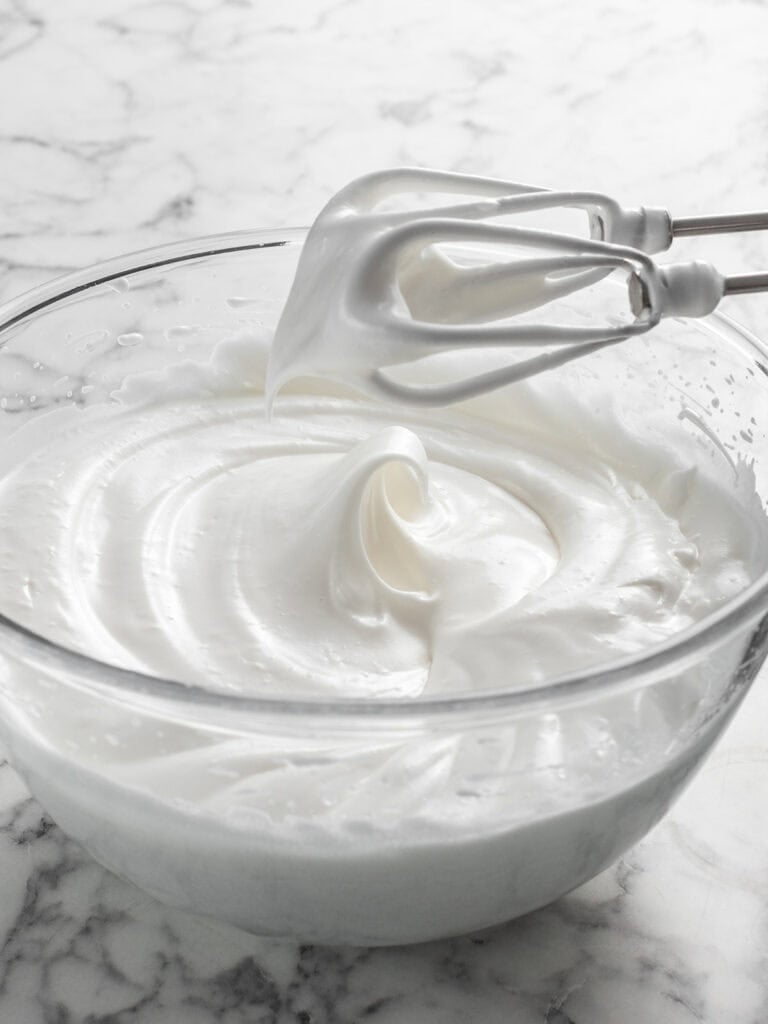
I start by pulsing the remaining 300g of hazelnuts until they’re small pieces, not powder. Set some of those aside to decorate the cake and then add the flour to the machine and pulse to a fine crumb
Then you want to move over to the meringue which is easy to make. Mix the eggs and cream of tartar in a bowl until they’re frothy and then slowly add the sugar while you mix. It’ll eventually turn into a thick and glossy meringue. This is what’s going to give your cake volume and fluff!
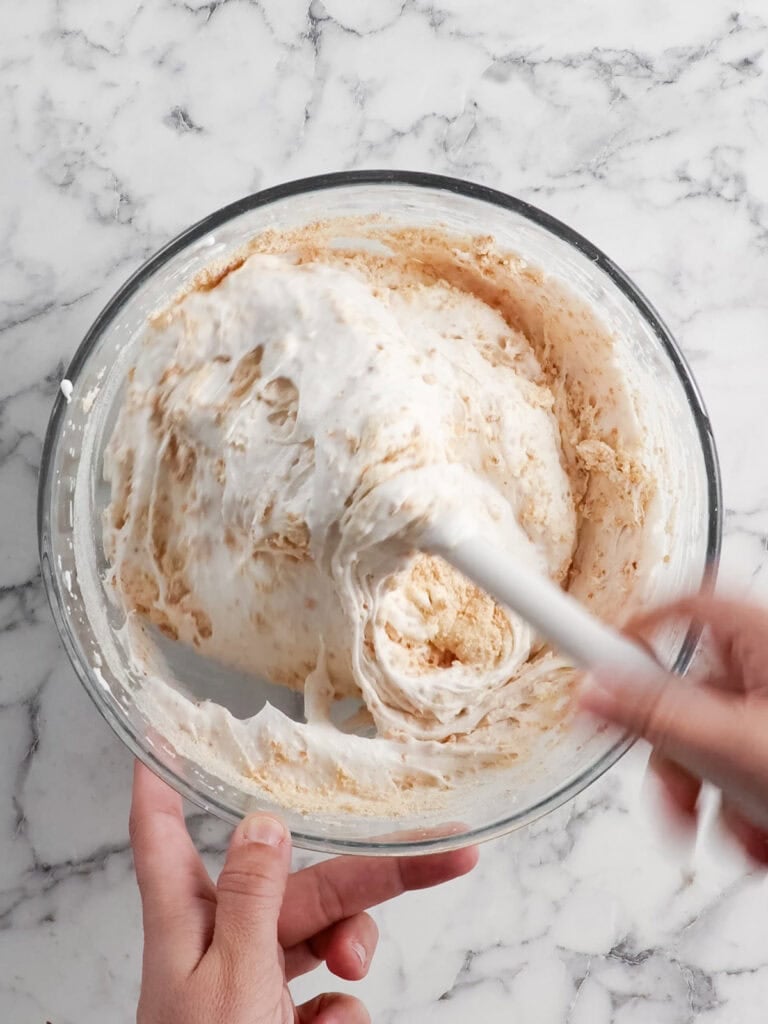
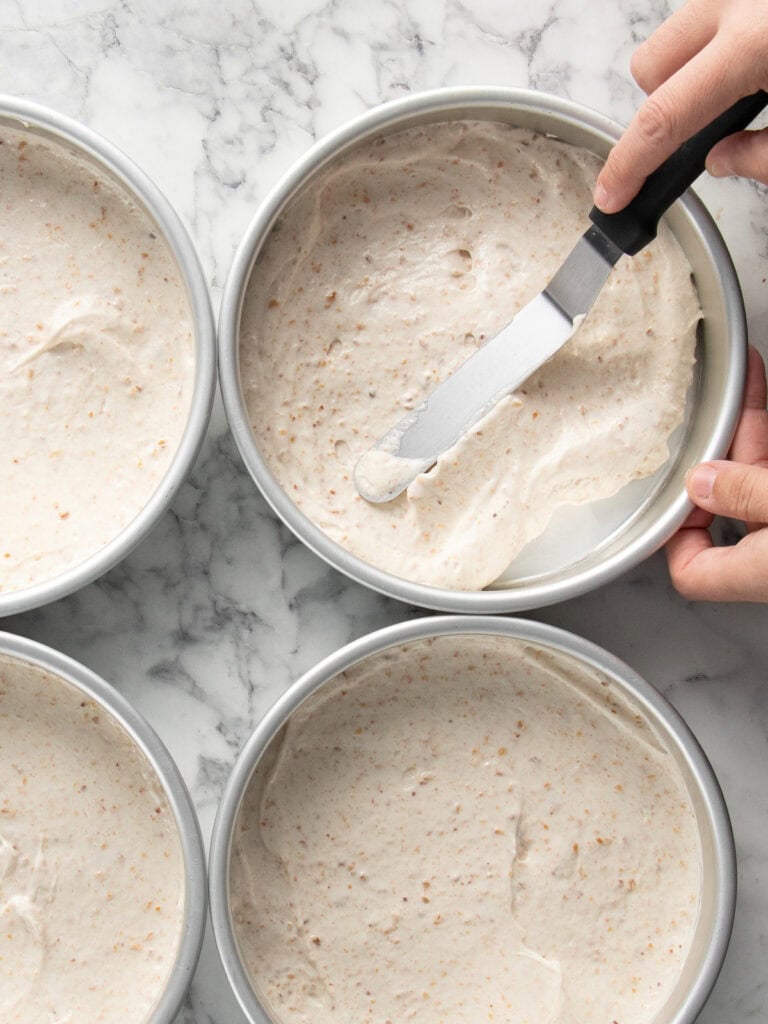
Finish the batter by adding the hazelnut mixture and fold through until well combined. Just be gentle when folding to make sure you don’t deflate the mixture. Then pipe it into the cake tins and spread evenly. You’ll need 4 of those but if you don’t have that many, just bake them in batches.
Once baked, let them cool and you’re ready to layer!
Tip: make sure you’re gentle when folding the dry ingredients through the meringue! We want to keep that air and not deflate it.
Layering the cake (Day 2)
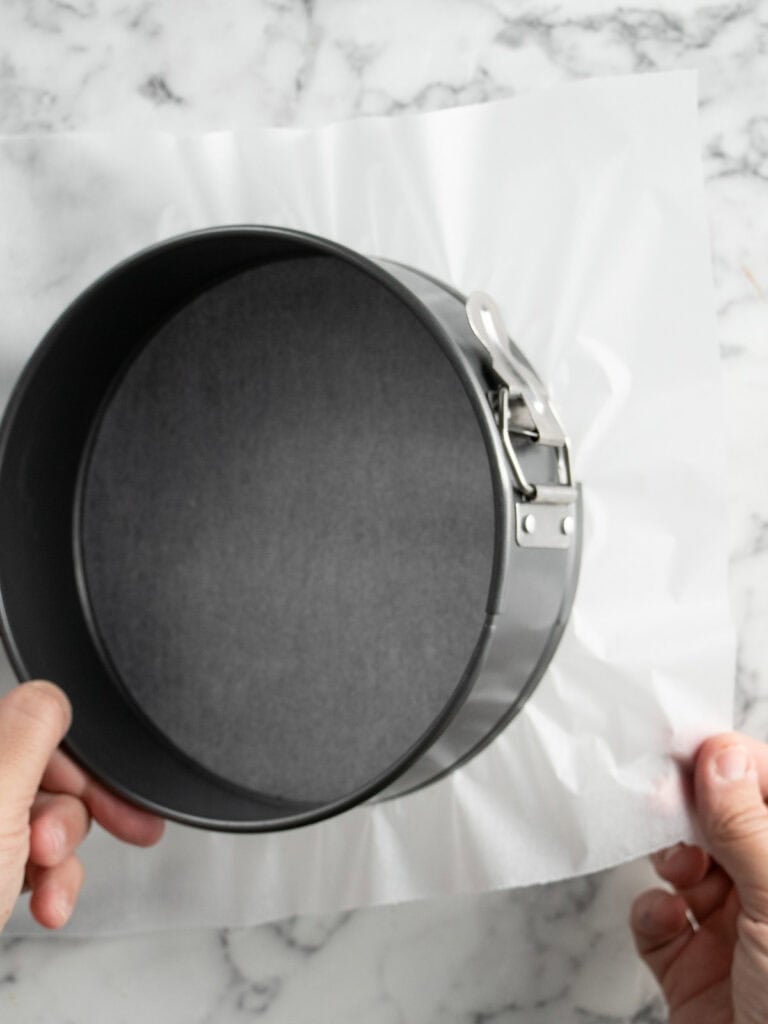
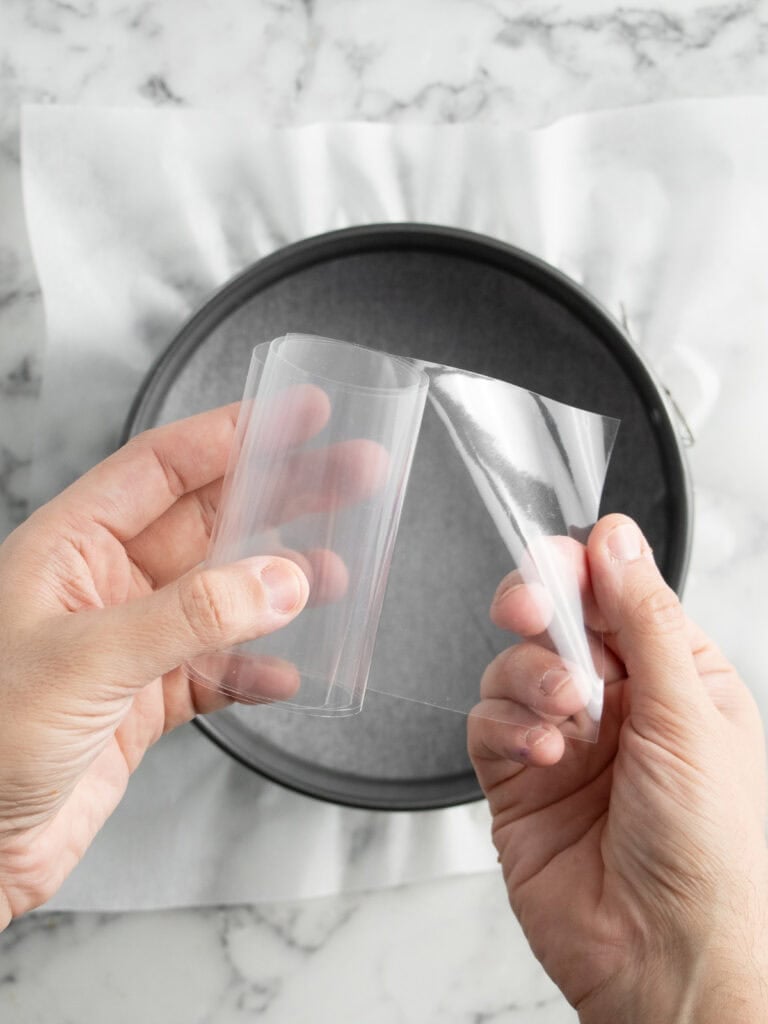
Layering is easy but the biggest piece of advice here is to use acetate and a spring-form pan that’s lined with baking paper at the bottom. The acetate is going to allow you to cleanly remove the cake from the cake tin when it’s set and the springform pan unclips so you can easily take it away from the cake.
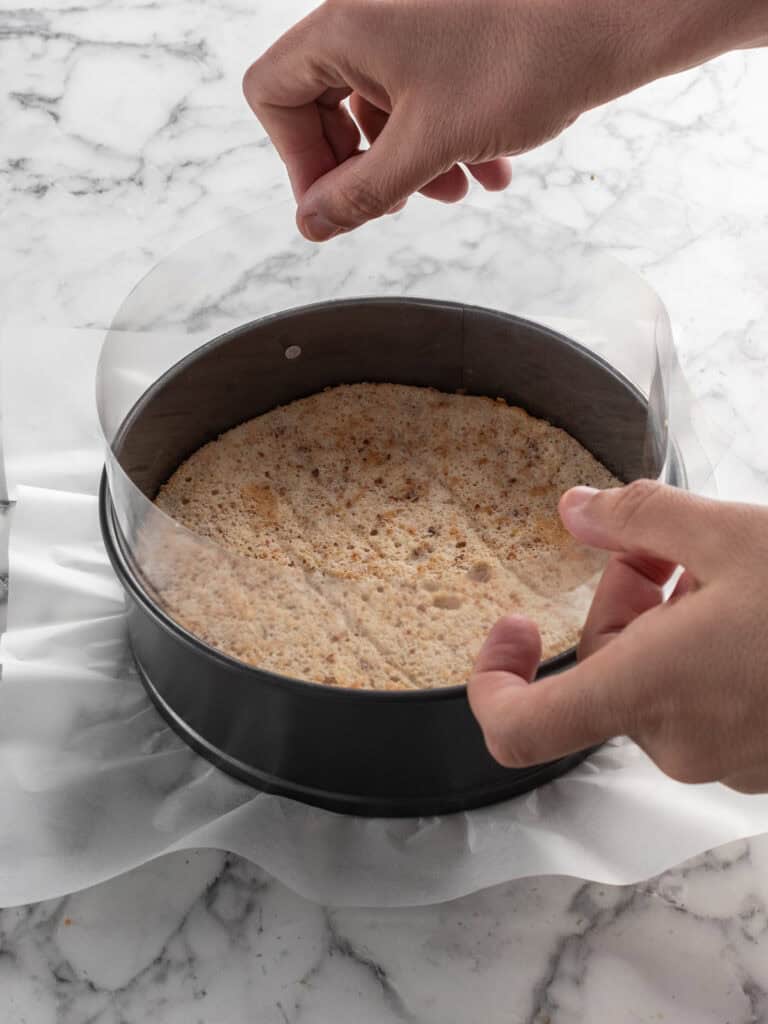
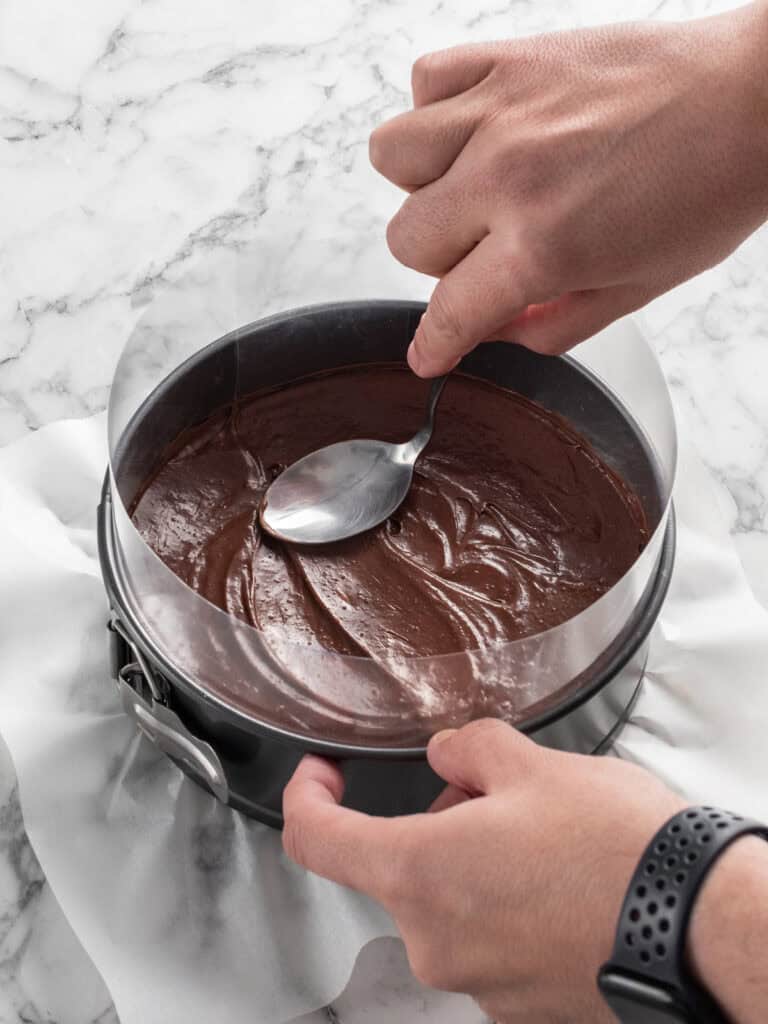
Layer the cake by alternating between cake layers and 1/4 of the pastry cream in each layer. You’ll use 3/4 of the pastry cream all up and then use the remaining cream to decorate the outside of the cake.
Tip: I bought my acetate online. I’ve got the exact measurements of how big it needs to be in the recipe card at the bottom of the post. If you don’t have acetate you can use plastic cling wrap.
Making the glaze (Day 2)
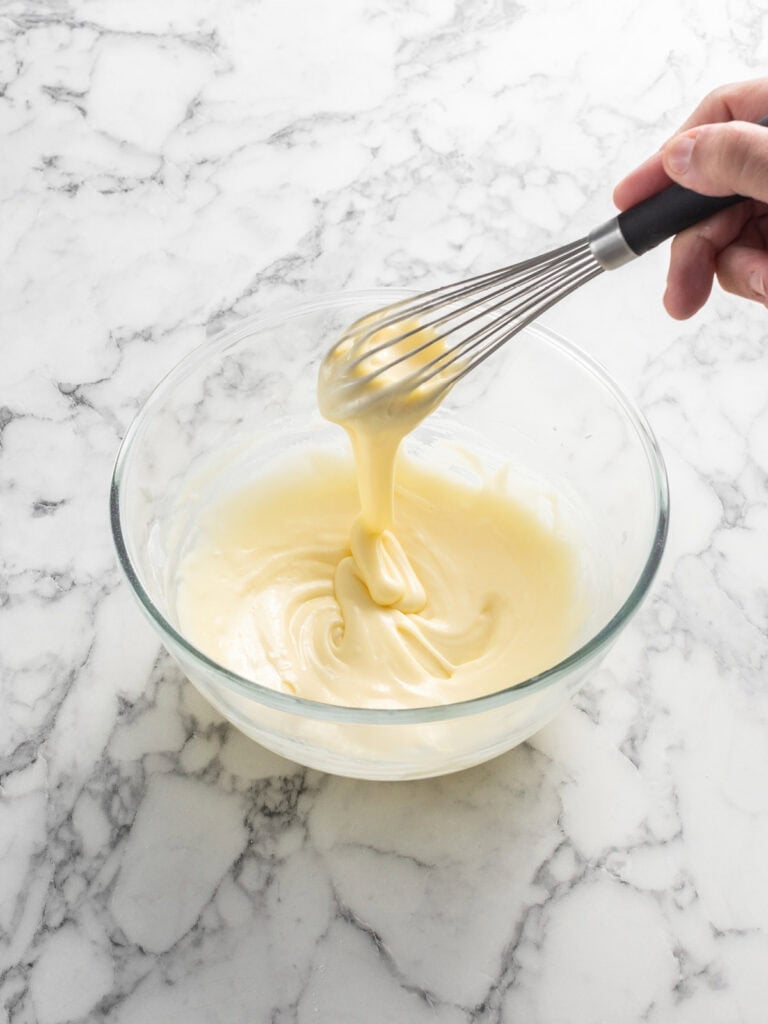
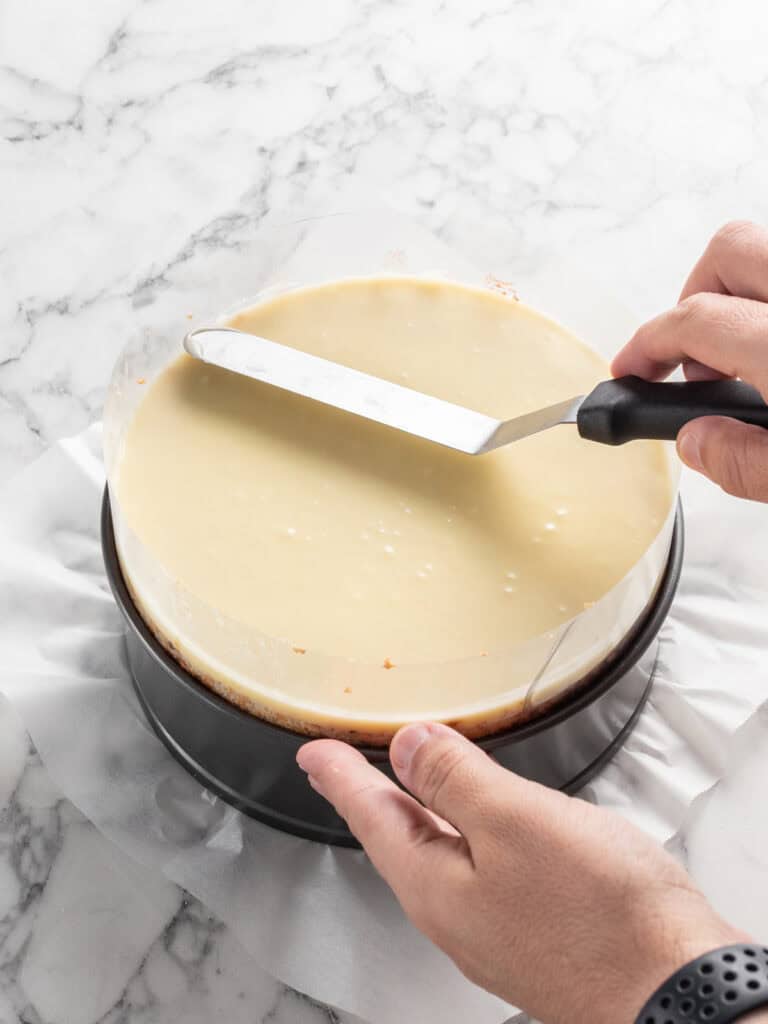
The glaze comes together really easily. Once you make the vanilla glaze pour most of it on the cake and then mix the remaining amount with a touch of cocoa powder.

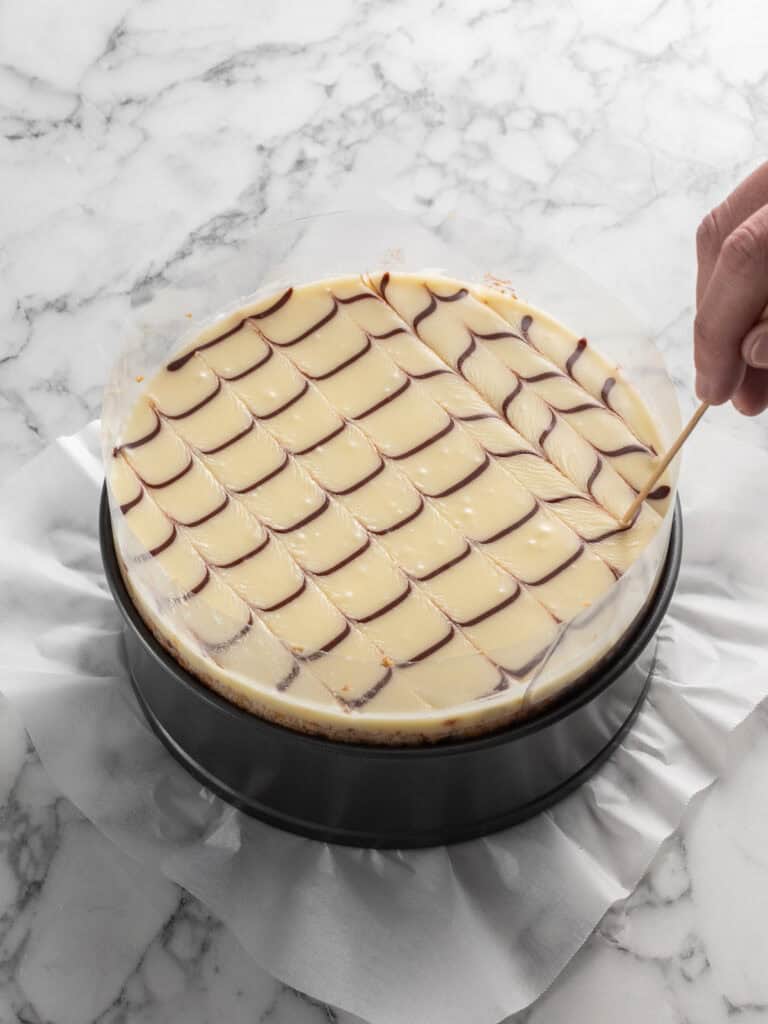
I like piping it in lines on the cake using a piping bag fitted with a small round tip. Go slow here and get it as neat as you can. Then feather it with a toothpick. I love this look because its so classic!
Now that the cake is layered and has the glaze, it needs several hours to set. Overnight is best.
Finishing touches (Day 3)
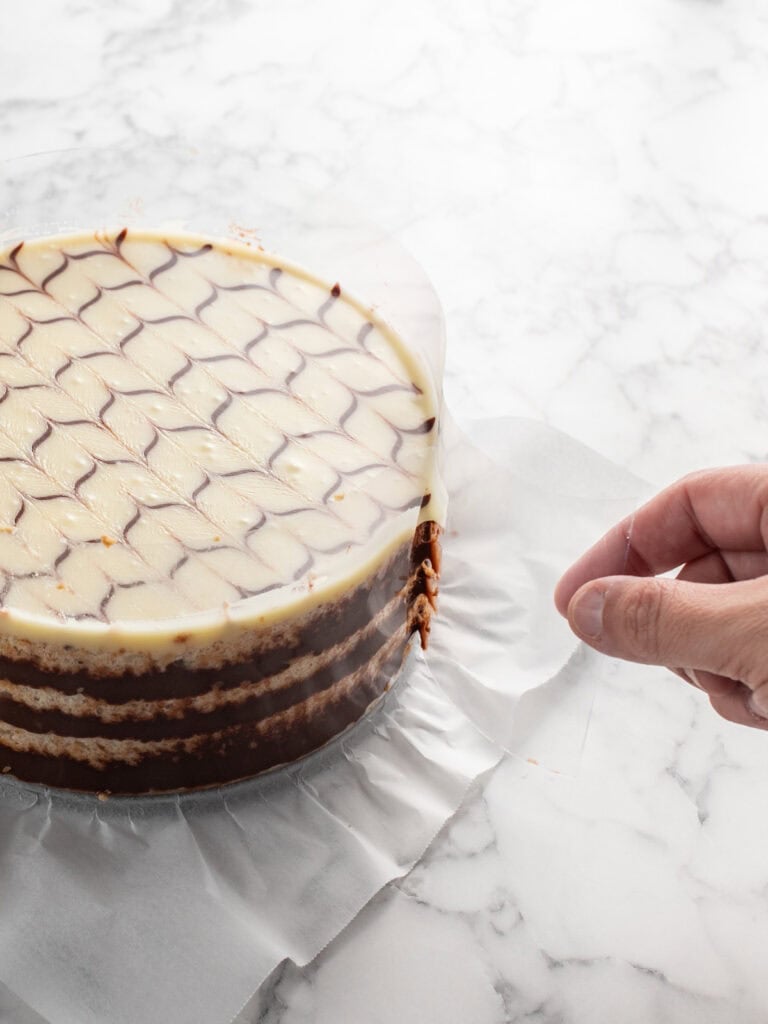
You want to unclasp the springform pan and take it away the acetate. Then transfer to your serving plate.
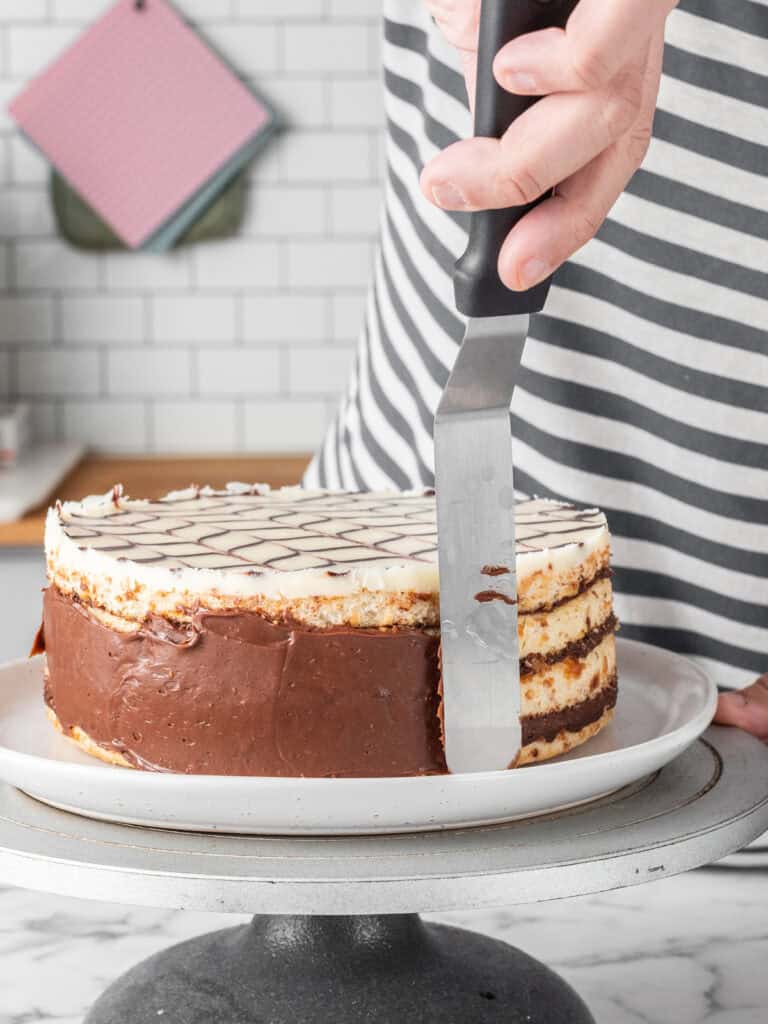
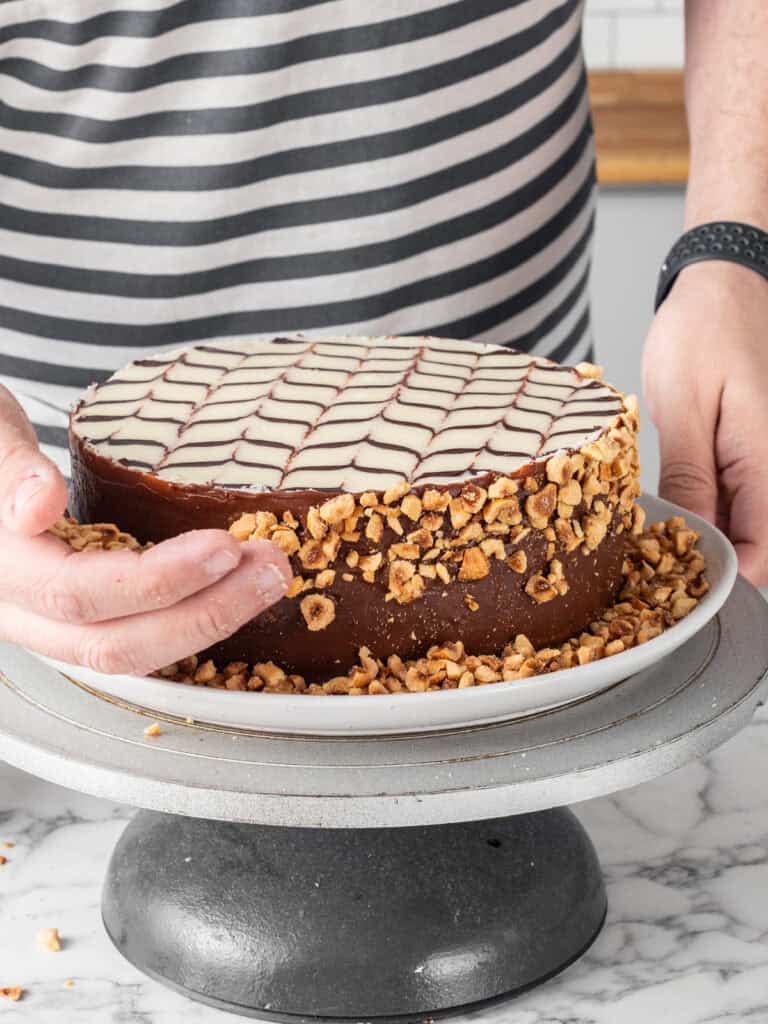
Cover the outside with the remaining pastry cream and spread using an offset spatula or spoon. Get it neat, but it doesn’t have to be perfect. Then cover in the remaining hazelnuts. Slice and serve!
Tip: To transfer your cake from the springform pan, slowly and carefully lift it from the excess baking paper over to your serving plate. Slowly lift one side of the cake away from the plate to peel the baking paper away.
Store your cake in an airtight container and leave in the fridge. It’s good for three days!
A Quick Baking Guide
If you’re new to baking or just want to brush up on the basics, these guides are a great place to start!
Loved the recipe? Let me know!
If you enjoyed this recipe, leave a star rating and comment below. It helps others find the recipe and keeps the baking community growing. Tag me on Instagram so I can see your version too!
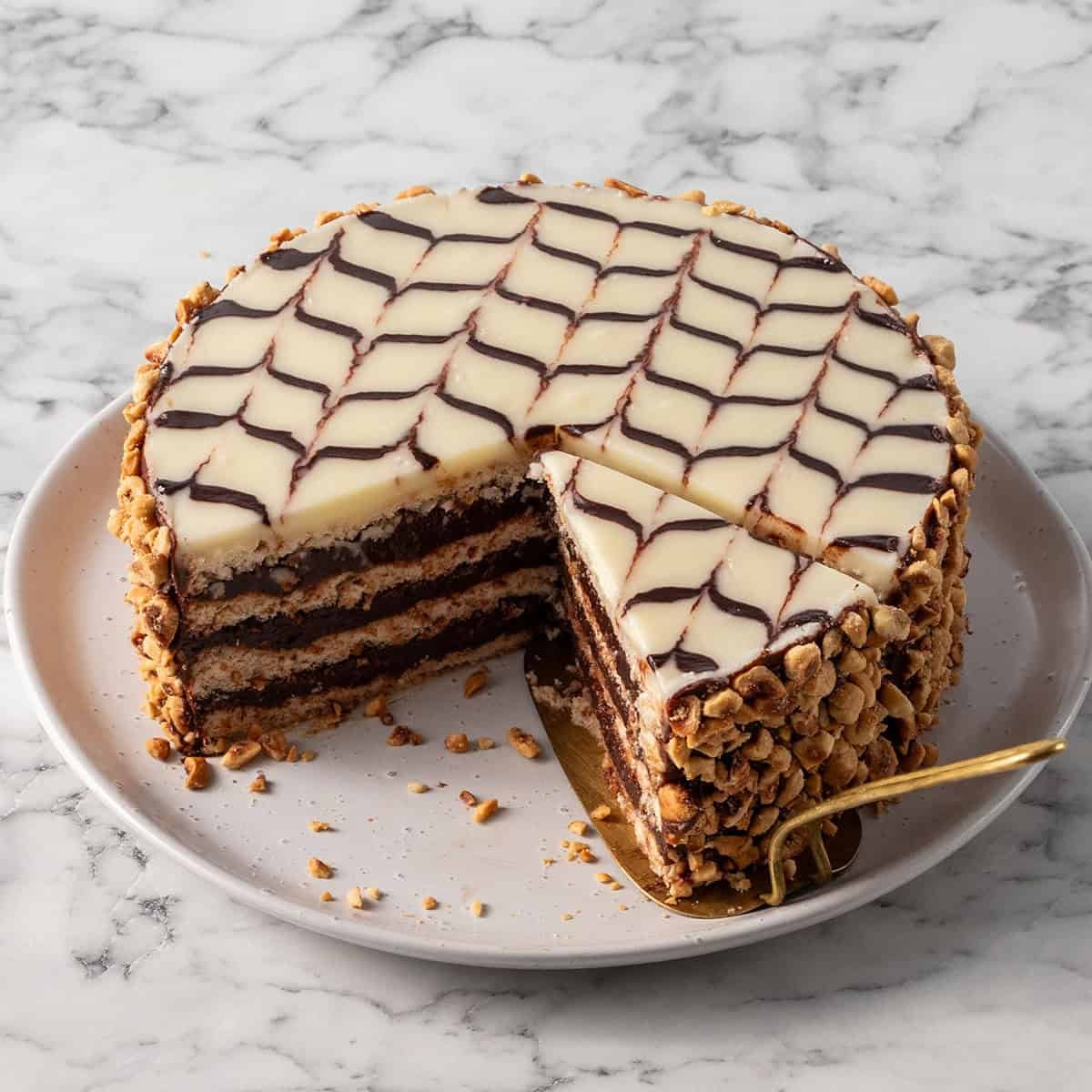
Hazelnut And Chocolate Layer Cake (Hungarian Esterhazy Torte)
Serves 8
Ingredients
Chocolate Pastry Cream
- 500 g whole milk, not skim
- 7 g vanilla bean paste or Pure Vanilla Extract
- 50 g corn starch, corn flour
- 20 g caster sugar, superfine sugar
- 10 g Dutch processed cocoa powder, see notes
- Pinch of fine salt
- 4 egg yolks
- 80 g unsalted butter, cubed and cold
- 180 g dark cooking chocolate, finely chopped (see notes)
Hazelnut Praline
- 150 g toasted hazelnuts, see notes
- 210 g granulated sugar
- 125 g water
- 55 g glucose syrup
- 1/2 tsp salt
- 1/2 tsp bicarbonate of soda, bicarb soda
Hazelnut Dacquoise
- 150 g toasted hazelnuts, for dacquoise
- 100 g all-purpose flour, plain flour, divided
- 9 egg whites, room temperature
- Pinch of cream of tartar, see notes
- 200 g caster sugar
- 7 g vanilla extract
- 1/2 tsp salt
- 150 g toasted hazelnuts, for coating the cake
Vanilla Glaze
- 55 g unsalted butter, melted and cooled
- 30 g whole milk
- 220 g powdered sugar
- 15 g glucose syrup
- 5 g Dutch processed cocoa powder, for chocolate glaze
Instructions
How To Toast The Hazelnuts
- Preheat your oven to 180C / 355F (fan off), 160C / 325F (fan on). Position your oven rack on the middle shelf.
- Toast all the hazelnuts – You’ll need 450g hazelnuts total for this recipe. They’re used in the praline, dacquoise, and to coat the finished cake. I’ll break down how much to use at each step as you go. To toast them, spread them on a baking tray and bake for 20 minutes or until golden. Stir halfway through. Let them cool completely.
Chocolate Pastry Cream
- Combine dry ingredients and eggs – Add the corn starch, sugar, cocoa powder and salt to a medium heavy-bottomed, stainless-steel pot. Use a hand whisk to combine, then add the egg yolks and whisk until smooth.
- Add the milk – Slowly pour in the warm milk, about 1/4 cup at a time, whisking well after each addition. Once all the milk is added, whisk in the vanilla.
- Cook pastry cream – Cook over medium heat while whisking constantly. After 3 to 4 minutes the mixture will thicken. Keep whisking until it starts to bubble, then cook for 90 seconds. For a firmer set, cook for up to 3 minutes before taking it off the heat.
- Add butter – Add 1/4 of the butter and whisk until it’s melted and well combined. Repeat until all the butter has been added. You want to do this slowly, so the pastry cream doesn’t split.
- Add the chocolate – Add the cooking chocolate and whisk until well combined.
- Run through a sieve – Run the thickened pastry cream through a sieve into a medium sized mixing bowl to get rid of any lumps.
- Chill to set – Cover the surface of the pastry cream with plastic wrap and chill in the fridge for 5 hours. Overnight is best.
Hazelnut Praline
- Combine water, sugar and glucose – Place sugar, water and glucose syrup in a large sized saucepan (stainless steel, not non-stick). Turn on medium high heat. Stir until sugar is dissolved.
- Caramelize the mixture – Lower the heat to medium and let it slowly bubble, stirring occasionally, until it turns deep golden color. You’ll know it’s done when it reaches 160C / 320F on a candy thermometer. Watch closely as it can burn quickly. If it smells burned, start again.
- Add bicarb soda and set – Once the syrup is golden in color, take it off the heat and add 150g of the toasted hazelnuts and salt and stir. Then add the bicarb soda and stir straight away until fully combined. It will puff up, so make sure you’re using a large saucepan. Pour onto a baking tray and let it cool for 20 minutes until set and hard.
- Process into paste – Break the cooled praline into smaller chunks. Be careful, the pieces can be sharp. Add to a food processor and blend on high. It will be loud at first and the processor might wobble, so hold it down until the pieces turn to powder. Keep blending, scraping down the bowl as needed, until a smooth paste forms. Transfer to a bowl and cover with plastic wrap.
- Adding the praline – once the chocolate pastry cream has chilled and set, add it to a food processor with all of the praline paste. Blend until completely smooth and well combined. Transfer back to the bowl, cover, and place in the fridge until ready to use.
Hazelnut Dacquoise
- Preheat your oven to 170C / 340F (fan off), 150C / 300F (fan on). Spray the bottom (not the sides) of four 22cm / 8-inch cake tins and line the bottom with baking paper. If you don’t have four cake tins, just use what you have and bake them one at a time. Set aside.
- Process hazelnuts – Add the remaining 300g of toasted hazelnuts to a food processor. Blitz until they reach a fine crumb texture. Scoop out 150g and set aside to coat the cake later.
- Add flour to hazelnuts – Add the flour to the food processor and blitz until fully combined. The hazelnuts should be evenly coated in the flour. Set aside.
- Whip meringue – Add the egg whites and sugar to a stand mixer fitted with a whisk attachment. Whip on medium high speed for 4 minutes until thick and glossy. Add the vanilla and salt, then whip for another 30 seconds. You can use a hand mixer if you prefer.
- Add dry ingredients – Stop the mixer and add the hazelnut flour mixture. Use a spatula to gently fold through until well combined and no dry spots remain. Scrape the bottom of the bowl as you fold, as dry bits like to hide there. The batter will be thick. Transfer to a piping bag.
- Add batter to cake tins – Pipe the batter into the tins in a spiral, starting from the centre. You can also scoop it in using an ice cream scoop and spread it out evenly with a spoon or offset spatula.
- Bake – Gently tap each tin on your bench three times to release air bubbles. Bake for 15 minutes. Let the cakes cool completely. Run a knife around the edge, then turn each one out by placing your hand flat over the top and flipping it. Stack with baking paper between each layer until ready to use.
Putting it together
- Line the bottom of a 22cm / 8-inch springform pan with baking paper.
- To layer the cake – Place one cake layer into a springform pan. Cut a strip of food-safe acetate 8cm / 3-inch high and 65cm / 25.5-inches long. Line the pan with the acetate, wedging the bottom between the cake and tin to hold it in place. Add one quarter of the chocolate pastry cream and spread it out evenly using an offset spatula or bent spoon.
- Continue layering – Add the second cake layer and spread over another quarter of the chocolate pastry cream. Repeat with the remaining layers. You should have used 3/4 of the pastry cream, saving the rest to coat the sides of the cake.
Glaze
- Vanilla glaze – To make the vanilla glaze add the powdered sugar to a small bowl along with the melted butter and mix using a whisk until well combined.
- Chocolate glaze – To make the chocolate glaze repeat the same process as above using the addition of sifted cocoa powder.
- How to add the glaze – Pour the vanilla glaze on top of the cake and gently spread it using a spoon or offset spatula. Add the chocolate glaze to a piping bag and snip the tip off. Pipe lines across the vanilla glaze, then drag a toothpick or skewer across the lines to create a feathered pattern.
- Chill the decorated cake – Place back in the fridge for 4 hours to set, overnight is best.
Let’s decorate!
- Take the chilled and set cake out of the springform and transfer to a serving plate using the baking paper at the bottom to help you.
- Coating the sides of the cake – Carefully unwrap the acetate from the chilled cake. Use the remaining chocolate pastry cream to coat the sides. An offset spatula gives you the smoothest finish, but a spoon works too. It doesn’t need to be perfect. Finish by pressing the reserved 150g of toasted hazelnut crumb onto the sides. A turntable will make this step easier.
52 comments
OK so I made this today and everyone absolutely adored it. I highly recommend this recipe!
The only thing I would say is that the recipe makes a large amount of the chocolate cream. Next time I might make half the batch of the chocolate cream!
Other than that, great recipe x
Hi Aisha! Thanks so much for the lovely comment! Glad you enjoyed the cake! N x
This looks really good, although the original Eszterházy is made with walnuts. This is Eszterházy with a twist
Thanks so much Bea!
Just wondering if anybody has used a gluten free flour for this recipe?
Hi Marie! I’ve never used it for this recipe but if you do, please be sure to let me know how you went! N x
The ingredient’s list show a total of 2 1/4 cups of hazelnuts to be used, but your directions state 4 1/4 cups. Could you please clarify?
Hi Raymond, thanks for letting me know that! I’ve gone in and updated the recipe! N x
Hi,
Still not clear on how many cups of hazelnuts are needed. You list 2 1/4c and state to toast that many. However, you use 1c for the praline leaving 1 1/4c. Those go in the food processor and then you set 2c aside for outside? Putting them in food processor should make them more dense and you didn’t even have 2c left. How much should be in the dacquoise?
Hi Reney! Sorry about that. Have gone in and made the recipe much clearer. It’s 3 1/4 cups of hazelnuts (whole) toasted. 1 cup for the praline, 1 1/4 cups for the cake and 1 cup to decorate 🙂 N x
I want very much to make this recipe but in a smaller size. Do you think it would work to halve this recipe and bake it in six-inch pans? Thank you.
I havent tested it as a smaller cake, but I think that should be ok. If you give it a go, let me know how it goes! N x
Hi, I want to attempt this for my husbands birthday, but there are alot of steps involved. Which portions can be made ahead and how can they be stored and for how long?
If there is alot of pastry cream leftover, can that be stored too?
Hi Fatima! You can make the cake and pastry cream up to three days in advance 🙂 Any left over pastry cream can be stored in the fridge for up to a week 🙂 N x
Thanks again for the great recipe!
As it is nearly impossible to buy corn or glucose syrup from an everyday supermarket in Turkey, can I make the hazelnut praline without the syrup?
Hey Dilekimu! So glad you’re enjoying the recipe! 😊 You can still make the hazelnut praline without the glucose syrup, but it might turn out a bit more brittle and less smooth. If you can’t find glucose syrup, you can try substituting with honey or a simple sugar syrup (just boil equal parts water and sugar until it thickens). Hope that helps and happy baking! N x
Hi Nick! This cake looks delicious! Can you please clarify the metric measurements? You have written 40g for the 1/4 c powdered sugar but then 25g for the 1/4 c cocoa powder and 60g for 1/4 c unsalted butter. I don’t want to add too much or too little of something, especially the ingredients. Do you spoon or pack the flour and cocoa powder in the dry measuring cups? I learned recently that not spooning flour into the measuring cup and instead directly scooping the flour from the container can add an additional 1/4 c of flour to the recipe so metric seems safer.
Thanks!
Hi Alie! Thankjs for your message asking for clarification. Those measurements are correct. I measure everything from my own kitchen using my own measuring cups and utensils to make sure what I’m making is what others will be able to make. Especialy when measuring in weight measurements. And you’re correct! Spooning into a measuring cup is the right way to measure. I plan to add some more info about that on the site this year. Hope that helps! N x
Hi Nick! The cake looks delicious! Planning to make it as a birthday cake for friends. Hazelnut is quite expensive here in Hong Kong – so I’m subbing the hazelnuts in the dacquoise with almond! Hopefully it’ll work!
How’d it go Mich? N x
Hi Nick! I made your red velvet cake last year and my family absolutely loved it. And that is a really good compliment considering I’m absolutely bad with baking. I did make it eggless with egg replacer (allergen friendly). So, this year I’m planning to make another cake from ScranLine! My question: Is there any way I can make Hazelnut cake eggfree as well? I can see eggs being used for hazelnut dacquoise and cream, and trying to think how can I make this eggless. Really keen to make this.
Hi Arzoo! That’s so sweet to say, I wish I could help with that. Unfortunately I don’t have much experience with egg free recipes and I’ve only ever tested it this way so I couldn’t say sorry!
Hi nick.
Are you able to make this without using the acetate?
Hi Belinda! Hmm, the reason the acetate is used is so that the mousse doesnt stick to the sides and comes out neat looking. I don’t think it would work without acetate I’m afraid. Sorry! N x
Is this recipe ok to use with two pans instead of 4? So I made two thicker layers?
Hi belinda! For this cake, I would reccomend baking in four pans or if you don’t have 4 pans, bake 2 at a time. The reason being is, I haven’t tested it with thicker layers. So I wouldn’t be able to say if it works or how long to bake. Even if it did work with a longer time, the outside would dry out quite a bit before the middle is fully baked. Hope that helps! N x
Hello Nick!
Amazing cake!
Just a question: the recipe says “Preheat and oven to 150C / 300C.” I don’t understand. What temperature exactly do we have to heat the oven to?
Thanks in advance.
Regards from the Canaries, Spain,
Hey Alicia!
Thanks so much! 😊 I’ve actually updated the recipe since then—great catch! You’ll want to preheat the oven to 150°C / 300°F (or 170°C / 340°F for no fan). I hope you enjoy making the cake, and feel free to share how it turns out!
Sending sweet vibes from Australia!
N x
Hello again!
Now I see: 150C / 300F. 😄
Can’t wait to give it a try!
Hey Alicia! Haha, glad it’s all clear now! 😄 So excited for you to try it—hope you have a blast making it! Don’t forget to share how it goes, I’d love to hear about it. N x
Hello from Egypt,
I want to make this cake but need it to be bigger in a 23-24 cm pan. Do I have to double the receipe or just increase it by half?
And if I don’t have four baking pans, can I bake the daquoise in only two bakkng pans and divide them with a knife later to obtain four layers? I am afraid the daquoise may deflate if I bake them in two batches. What do you think?
Thanks in advance 🙂
Eman
Hey Eman!
Hello from Australia! 😊 If you’re using a 23-24 cm pan, I’d recommend increasing the recipe by half to get a nice height and even layers. As for baking the dacquoise in two pans, I totally get your concern! You can absolutely do that, just be sure not to overfill the pans. After baking, use a sharp knife to carefully slice each layer in half. The dacquoise shouldn’t deflate, but to keep it extra airy, make sure your meringue is thick and glossy before baking.
Good luck, and I can’t wait to see how it turns out!
N x
I liked the pastru cream but overall I thought the cake tasted like a crunchy Nutella sandwich. I guess it’s not really cake. I made it for my family, they loved it but me not so much. It looked really good but I wouldn’t make it again. I’m using the remaining pastry cream on banana bread.
Ok, but just so we’re clear, Nutella is made of hazelnuts and is chocolate flavored. So is this cake. So I’m not sure how that was a disappointment. Enough for 3 stars lol. It literally says chocolate hazelnut cake.
The hazelnut praline is not hardening for me – I’m not sure what I am doing incorrectly, but it ends up a thick gooey mess rather than hardening into candy that you can break up like in the video. I’m hesitant to put the gooey mixture into a food processor, any idea what could be going wrong? It does seem like the liquid portion of the mixture is a lot more than what is shown in the video, although I followed the amounts listed in the recipe.
Hey Lauren! It sounds like the sugar might not have reached the right temperature for the praline to harden properly. Make sure the syrup reaches 150-155°C (300-310°F), which is the hard crack stage, before taking it off the heat. This ensures it will harden once it cools. If it’s still gooey, try cooking it a little longer to reach that temp. I totally get being hesitant to put it in the food processor if it’s not firm—just give it a bit more time on the heat next time. Hope that helps! N x
Hi Nick
Can the cake layers be made ahead and frozen, then thawed night before assembling it? Going to make for my daughters 13th but there’s a few steps here and thinking if it can be made ahead and frozen would save me some time. Thanks!
Hey Hanna! Yes, you can absolutely make the cake layers ahead and freeze them. Just wrap them tightly in plastic wrap and pop them in an airtight container. Thaw them in the fridge the night before assembling, and they’ll be good to go! Perfect for saving time with a recipe like this. Wishing your daughter a happy 13th! N x
Hi Nick can glucose be substituted with something else?
Hi Eleni, you can use corn syrup if that works for you!
Hi Nick, love the look of this recipe but don’t have a large food processer. I do have a small one so that I could make the hazelnut paste…..as tedious as it would be in very small batches!😀 Do you think I’d still get the pastry cream smooth enough by beating with a paddle beater? Am really keen to try this but not if you think it won’t work with the equipment in my kitchen.
Cheers, Mary
Hi Mary! Hmmm. unfortunately it wont get as smooth using a stand mixer with a paddle sorry!
I’m always interested in different recipes and will definitely try this.
I grew up in a small town in Canada called Esterhazy and it was a Hungarian community. My dad’s side is Hungarian and I grew up with having a Hungarian Dobas Torta cake at my grandparents at Christmas time. It was the most delicious cake with several layers 6-8 with a chocolate filling….no hazelnuts. I still carry on this Christmas tradition 😀
Hi Tammy, I had to google that cake because I’ve never heard of it and it sounds absolutely amazing! I’ve already got a long list of recipes to create, but I’m adding this one to my list. It looks amazing and definitely worth perfecting! N x
Hi
Can I use store bought hazelnut meal in the Dacquoise will that be ok?
Planning try this out
Thanks so much
Thanusha
Hey Thanusha! Yes, you can definitely use store-bought hazelnut meal for the dacquoise—it’ll work just fine! Just make sure it’s fresh and finely ground for the best texture. Can’t wait for you to try it out! N x
Hi Nick. Your recipe for the pastry cream states 4 egg yolks and no flour, only corn flour but in your video, you say there are 9 eggs. Is it 4 or 9 egg yolks for this recipe
Is there flour and if so, how much?
Hi Valerie, great question! The written recipe is the most up-to-date version, so it’s 4 egg yolks and no flour—just corn flour (also called cornstarch). I’ve updated the recipe since filming the original video, and a new video will be going up soon with all the current steps. Thanks so much for checking in! N x
Hi Nick…Still waiting on a reply for my Comments about the egg yolk quanity in written recipe vs. video as well as the addition of flour in your video vs. the omission of this in the written recipe. I made the pastry cream using 9 egg yolks and with the addition of flour as well as cornflour and that was challenging as it thickened up very, very quickly…I’m keen on making this cake again for my sons wedding next week but would like your feedback otherwise i’ll just use another recipe for the same cake
Hi Valerie, I’m so sorry for the delay in getting back to you. You’re absolutely right to notice the difference. The video was filmed before I finalised the current version of the recipe. The written recipe now reflects all my latest testing, which uses 4 egg yolks and only corn flour (no plain flour). That version gives you a smooth, pipeable pastry cream that still sets beautifully between the layers without thickening too quickly.
I totally understand how using 9 yolks and flour would make it hard to work with—thank you for giving it a go anyway! If you decide to make it again for your son’s wedding (what an honour!), I’d definitely recommend following the written version. And a new updated video will be going up very soon to match it. N x
Thanks Nick. Appreciate the feedback. And now i’ll be making double quantity for a bigger version for the wedding. It was delicious by the way. The pastry cream filling with the praline paste tasted exactly the same as the middle of a
Ferroro Rocher! My background is Hungarian so not even my Mum has attempted this one. She loved it.
Thanks Valerie, that honestly means a lot. So glad it reminded you of Ferrero Rocher and that your mum loved it too. Good luck with the wedding batch, hope it turns out amazing. N x